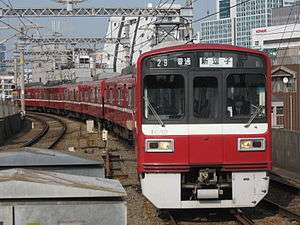Keikyu 1500 series
| Keikyu 1500 series | |
|---|---|
|
6-car set 1643, March 2010 | |
| In service | 1985– |
| Constructed | 1985–1991 |
| Refurbishment | 2002– |
| Number in service | 166 vehicles (28 sets) |
| Formation | 4/6/8 cars per trainset |
| Operator(s) | Keikyu |
| Specifications | |
| Car body construction | Aluminium, steel (sets 1501 to 1517)) |
| Car length | 18,000 mm (59 ft 1 in) |
| Width | 2,830 mm (9 ft 3 in) |
| Doors | 3 pairs per side |
| Maximum speed | 120 km/h (75 mph)[1] |
| Electric system(s) | 1,500 V DC |
| Current collection method | overhead wire |
| Multiple working | 600 series, N1000 series, 2000 series, 2100 series |
| Track gauge | 1,435 mm (4 ft 8 1⁄2 in) |
The Keikyu 1500 series (京急1500形) is an electric multiple unit (EMU) train type operated by private railway operator Keikyu on commuter services in the Tokyo area of Japan since 1985.[1]
Operations
The 8-car sets are primarily used on limited-stop "Rapid Limited Express" and "Limited Express" services on the Keikyu Main Line, including through-running services to and from the Toei Asakusa Line subway, Keisei Main Line, and Hokuso Line.[1] The 4- and 6-car sets are mostly used on all-stations "Local" services.[1] The 1500 series sets can be used in multiple with other Keikyu EMU types, including the 600 series, N1000 series, 2000 series, and 2100 series.[1]
Formations
As of 1 April 2012, the fleet consists of 166 vehicles formed as 4-car, 6-car, and 8-car sets, as follows.[2]
4-car sets 1501 to 1525
| Designation | M1c | M2 | M1 | M2c |
|---|---|---|---|---|
| Numbering | 15xx | 15xx | 15xx | 15xx |
- The "M1c" and "M1" cars are each fitted with one lozenge-type pantograph.[2]
- Sets 1501 to 1517 have steel bodies. All other sets have aluminium bodies.[2]
6-car sets 1529 to 1649
11 x 6-car sets formed by adding two 1900 trailer cars to 4-car sets.
| Designation | M1c | M2 | Tu | Ts | M1 | M2c |
|---|---|---|---|---|---|---|
| Numbering | 1xxx | 1xxx | 19xx | 19xx | 1xxx | 1xxx |
- The "M1c" cars are fitted with one lozenge-type pantograph, and the "M1" cars are fitted with two.[2]
6-car sets 1533 to 1549
| Designation | M1c | M2 | M1 | M2 | M1 | M2c |
|---|---|---|---|---|---|---|
| Numbering | 15xx | 15xx | 16xx | 16xx | 15xx | 15xx |
- The "M1c" and "M1" cars are each fitted with one lozenge-type pantograph.[2]
8-car sets 1701 to 1731
6 x 8-car sets formed by adding two 1900 trailer cars to 6-car sets.
| Designation | M1c | M2 | Tu | Ts | M1 | M2 | M1 | M2c |
|---|---|---|---|---|---|---|---|---|
| Numbering | 17xx | 17xx | 19xx | 19xx | 17xx | 17xx | 17xx | 17xx |
- The "M1c" and end "M1" cars are each fitted with one lozenge-type pantograph, and the centre "M1" cars are fitted with two.[2]
Interior
Passenger accommodation consists of longitudinal bench seating throughout.[1]
History
The 1500 series fleet was built between 1985 and 1991.[1] The first five 4-car sets delivered had steel bodies, while all subsequent sets had aluminium bodies with door pocket windows discontinued.[1] Sets built from 1990 onward used VVVF control.[1]
A programme of life-extension refurbishment commenced in 2002. This involved adding new air-conditioning units, removing the original door pocket windows of the steel bodied cars, and adding front-end skirts.[1]
References
External links
| Wikimedia Commons has media related to Keikyu 1500 series. |
- Keikyu 1500 series official information (Japanese)
| ||||||||||||

